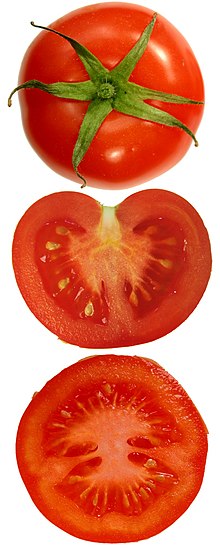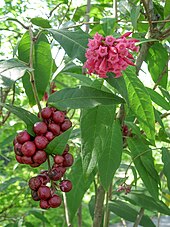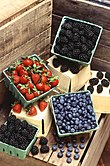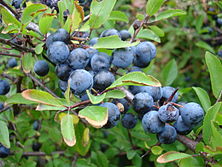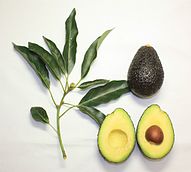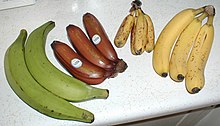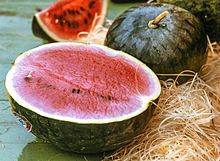Berry
In botany, a berry is the most common type of simple fleshy fruit, in which the entire wall of the ovary matures, usually into a fleshy, edible pericarp. In the strictest definition of the term the ovary is superior in these flowers. They have one or more carpels within a fine covering, the interiors are very fleshy, and the seeds are dispersed in the pulp.
There are also multiple berries, or polyberries, which are syncarps, such as cherimoyas (Annona cherimola and other species of the genus).
The particular berries of the Cucurbitaceae family (watermelon, melon, cucumber, pumpkins) have an inferior ovary, in addition to the mark on the peduncle, the fruit has the scar left by the floral pieces when they fell at the other end of the stem. the berry, and the exocarp and sector of the mesocarp closest to the outside harden into a shell that allows storage of the tender interior for months to a year. The berry of the cucurbits is called pepónide, cultivated varieties selected so that the skin is less hard and easy to handle are common.
Gourds, in the original meaning of the term, are berries with such a hardened shell that not only allows the preservation of the tender interior for one or more years, but also can be used empty for non-food purposes, such as kitchen utensils, in musical instruments, handicrafts, etc. Known gourds belong to both the Cucurbitaceae (Lagenaria, varieties of Cucurbita) and the Bignoniaceae (Crescentia, Amphitecna). In some regions the term was extended to designate selected varieties with a not so hard shell and not usable for non-food purposes, which can be cut with a kitchen knife and which retains the fleshy interior for one year: the rest of the Cucurbita, and Benincasa.
Examples of berries are grapes and tomatoes, but many other common fruits are botanically considered berries: hesperidia such as orange and lemon are modified berries; persimmon, eggplant, guava, and bell pepper are considered berries as well.
In plant species with an inferior ovary, the floral tube may mature together with the ovary, creating an accessory fruit that was once called pseudberry or false berry, terms that are not currently used, also calling those with an inferior ovary berry. Banana, gooseberry, blueberry and peponides (cucumber, pumpkin, watermelon, melon) among others are included in this category.
Many berries are small, juicy, shiny, and of a color that contrasts with the background to be easier for the animals that disperse them to see, this strategy is very common not only in berries but in other types of fruit.
In Spanish, baya is not the same as fruit of the forest. Care must be taken because in many other languages the same word refers to both concepts; for example, grapes are berries but not berries, strawberries are berries but not berries, and currants are both types of berries.
Evolution and phylogenetic significance
By definition, berries have a fleshy, indehiscent pericarp, as opposed to a dry, dehiscent pericarp. Fossils show that the first flowering plants had dried fruits; fleshy fruits, such as berries or drupes, only appeared towards the end of the Cretaceous Period or the beginning of the Paleogene Period, about 66 million years ago. The increasing importance of seed dispersal by frugivorous vertebrates, both mammals and birds, may have driven the evolution of fleshy fruits. Another possibility is that the causal direction is the opposite. Large fleshy fruits are associated with moist habitats with closed tree canopies, where wind dispersal of the nuts is less effective. These habitats were becoming more common in the Paleogene, and the associated change in fruit type may have led to the evolution of fruit-eating in mammals and birds.
Fruit type has been considered a useful character in classification and in understanding plant phylogeny.The evolution of fruits with a berry-like pericarp has been studied in a wide range of families of plants with flowers. Repeated transitions between fleshy and dry pericarps have been regularly demonstrated. A well-studied family is that of the Solanaceae, due to the commercial importance of fruits such as tomatoes, peppers and aubergines. Capsules, which are dry dehiscent fruits, appear to be the original fruit shape in the earliest divergent members of the family. The berries have thus evolved at least three times: in Cestrum, Duboisia, and in the subfamily Solanoideae. Detailed anatomical and developmental studies have shown that the berries of Cestrum and those of the Solanoideae are significantly different; for example, fruit expansion during development involves cell divisions in the mesocarp in Solanoideae berries, but not in Cestrum berries.
When the fruits described as berries in the Melastomaceae family were studied, it was found that their structure was highly variable, some being soft with an endocarp that broke quickly, while others had a hard and persistent endocarp, even woody in some species. Fruits classified as berries are thus not necessarily homologous, with the fleshy part derived from different parts of the ovary, and with other structural and developmental differences. The presence or absence of berries is not a reliable guide to phylogeny. In fact, fruit type in general has proven to be an unreliable guide to flowering plant relationships.
Berry-like fruits
Many fruits commonly referred to as berries are not actually berries by scientific definition, but rather fall into one of the following categories:
Drupes
Drupes are variably distinguished from botanical berries. Drupes are fleshy fruits produced from a (usually) single-seeded ovary with a hard, woody layer (called an endocarp) surrounding the seed. Some well-known examples are stone fruits of the genus Prunus (peaches, plums, and cherries), olives, coconuts, dates, bay leaves, and Persea' species. Some definitions make the mere presence of an internally distinct endocarp the defining characteristic of a drupe; others qualify the nature of the endocarp required in a drupe, for example by defining that berries must have an endocarp less than 2 mm thick. The term "drupaceous" used for fruits that have the general structure and texture of a drupe, without necessarily meeting the full definition. Other single-seeded drupe-like fruits lacking the stony endocarp are the sea buckthorn (Hippophae rhamnoides, Elaeagnaceae), which is an achene, surrounded by a swollen hypanthium that provides the fleshy layer. Fruits of Coffea species are described as drupes or berries.
Knob
The pome-shaped fruits produced by plants of the Pyrinae subtribe of the Rosaceae family, such as apples and pears, have a structure (the core) in which a hard tissue clearly separates the seeds from the outer pericarp more soft.The bubbles are not berries. However, some of the smaller bubbles are sometimes referred to as berries. Amelanchier the buds become so soft at maturity that they resemble a blueberry and are known as Juneberries, serviceberries, or Saskatoon berries.
Compound fruits
The aggregate or compound fruits contain seeds from different ovaries of a single flower, with the "little fruits" individual united at maturity to form the complete fruit. Examples of aggregate fruits commonly called "berries" they include members of the genus Rubus, such as blackberries and raspberries. Botanically, these are not berries. Other large aggregate fruits, such as the soursop (Annona muricata), are not usually called "berries", although some sources use this term.
Multiple Fruits
Multiples are not botanical berries. Multiple fruits are the fruits of two or more multiple flowers that are fused or closely packed together. The blackberry is an example of a multiple-fruited berry; it develops from a cluster of small, separate flowers that are compressed as they develop into the fruit.
Accessory fruits
Accessory fruits are not botanical berries. In accessory fruits, the edible part is not generated by the ovary. Examples similar to berries include:
- Strawberry - the non-carnate aggregate of achenes on its exterior is actually the "fruit", derived from an aggregate of ovaries; the fleshy part develops instead from the receptacle.
- False strawberry (false strawberry)Duchess indicates- structured as a strawberry.
- Uva de mar (Coccoloba uvifera; Polygonaceae) - the fruit is a dry capsule surrounded by a fleshy chalice.
Uses
Culinary
Berries, imprecisely defined, have been valuable as a food source for humans since before the advent of agriculture, and continue to be among the top food sources for other primates. Botanically defined berries with culinary uses include:
- Beads in the strictest sense: including bananas and bananas, blueberries, red blueberries, coffee berries, currants, red, black and whitecurrants, tomatoes, grapes and peppersCapsicum fruits).
- Hesperidia: citrus, including oranges, lemons and limes.
- Pepos: cucurbitaceae, such as pumpkins, cucumbers, melons and watermelons.
Some berries are brightly colored, due to plant pigments such as anthocyanins and other flavonoids. These pigments are located mainly on the outer surface and in the seeds. These pigments have antioxidant properties in vitro, but there is no reliable evidence that they have antioxidant or any other useful functions within the human body.. Consequently, it is not permitted to claim that foods containing plant pigments have antioxidant health value on product labels in the United States or Europe.
Some spices are made from berries. Allspice is made from the dried berries of Pimenta dioica. The fruits (berries) of different cultivars of Capsicum annuum are used to make paprika (slightly spicy), chili (hot) and cayenne (very hot).(Weiss, 2002, p. 216)
Others
Pepos, which are characterized by a hard outer rind, have also been used as containers by removing the inner pulp and seeds and then drying the remaining exocarp. The English name Lagenaria siceraria, "bottle gourd," reflects its use as a container for liquids.
Some true berries have also been used as a source of dye. In Hawaii, these included berries of a species of Dianella, used to produce blue, and berries of the black nightshade (Solanum americanum), used to produce green.
History
The berries of the cucurbits or pepos, particularly Cucurbita and Lagenaria, are the first plants of which there is evidence of their domestication - before 9,000- 10,000 BP in the Americas, and probably around 12,000-13,000 BP in Asia. Peppers were domesticated in Mesoamerica around 8,000 BP. Many other early cultivated plants were also berries by the strict botanical definition, including grapes, domesticated around 8,000 BP and known to be used in wine production around 6,000 BP.
Bananas were first domesticated in Papua New Guinea and Southeast Asia. [Archaeological and paleoenvironmental evidence from the Kuk Swamp in the Western Highlands Province of Papua New Guinea suggests that banana cultivation dates back to at least 7,000 BC, and possibly 10,000 BC.
The history of citrus cultivation remains unclear, although some recent research suggests a possible origin in Papua and not mainland Southeast Asia. Chinese documents show that tangerines and grapefruit were established in cultivation there by 4200 BC. C.
Commercial production
According to FAOSTAT data, in 2013 four of the top five fruit crops in terms of world production by weight were botanical berries. The other was a pip (apples). (The 2013 production quantity data for the world total for all items was downloaded into an FAOSTAT spreadsheet. Items coded 486 to 626, corresponding to fruits, were retained. Data for bananas and bananas, as these are not distinguished in all countries. Data for all citrus were also combined, as some countries provide data under a general heading of "citrus.". The resulting table was sorted and they used the first five innings.)
| Name | Thousands of tons | Type of fruit |
|---|---|---|
| Bananas & bananas | 144,592 | Baya |
| Citrics† | 135.761 | Baya (hesperidium) |
| Melons | 109.279 | Baya (peep) |
| Apples | 80,823 | Poma |
| Uvas | 77,181 | Baya |
†Citrus fruits include (but are not limited to) oranges, lemons, limes, grapefruit (including grapefruits), tangerines, clementines and satsumas. Oranges make up 53% of the total.
According to FAOSTAT, in 2001, bananas (including plantains) and citrus comprised over 25% by value of the world's exported fruits and vegetables, citrus fruits being more valuable than bananas. Export quantities of fruit are not entirely comparable with production quantities, since slightly different categories are used. The top five fruit exports by weight in 2012 are shown in the table below. The top two places are again occupied by bananas and citrus. (The 2012 world export volumes for all fruits have been taken from FAOSTAT. Regarding production, items with codes 486 to 626 (but excluding 564 wine, not present in the production data) were retained. Banana and plantain data have been combined, as well as citrus information.)
| Name | Thousands of tons | Type of fruit |
|---|---|---|
| Bananas & bananas | 19.725 | Baya |
| Citrics† | 15,262 | Baya (hesperidium) |
| Apples | 8,271 | Poma |
| Prepared fruit‡ | 7,120 | - |
| Uvas | 4,051 | Baya |
†Citrus includes oranges, lemons, limes, grapefruit (including pomelos), mandarins, clementines, and satsumas. Oranges represent 43% of the total.
‡Prepared fruit refers to "fruit, nuts and shells, including frozen, prepared or preserved, sweet, paste, jam, puree and cooked fruits, in addition to those already indicated above".
Contenido relacionado
Elymandra
Coelachyrum
Miliusa

